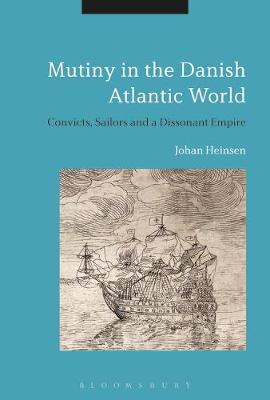11%OFF

Stock image for illustration purposes only - book cover, edition or condition may vary.
Mutiny in the Danish Atlantic World: Convicts, Sailors and a Dissonant Empire
Johan Lund Heinsen
€ 138.66
€ 123.56
FREE Delivery in Ireland
Description for Mutiny in the Danish Atlantic World: Convicts, Sailors and a Dissonant Empire
Hardback. Num Pages: 240 pages, 3 bw illus. BIC Classification: HBG; HBLH; HBTQ. Category: (U) Tertiary Education (US: College). Dimension: 234 x 156. .
*** Danish Historical Society Award Winner (2018) Historical research result of the year *** Mutiny in the Danish Atlantic World discusses how the storytelling of the lower classes shaped antagonisms and struggles for agency in the early modern Atlantic. It takes a mutiny carried out by a group of convicts and sailors on board a Danish ship, the Merman, in 1683 as its central case study. En route to Denmark's Caribbean colony of St. Thomas, the mutineers seized the ship, murdered the captain and six others and elected a former convict as their new leader. This event brought the West India Company to the brink of destruction and changed the course of the fledgling Danish maritime empire forever. Arguing that the mutiny on the Merman was informed by stories and rumour that circulated on both sides of the Atlantic and echoed on the lower deck of the ship itself, Johan Heinsen explores the role of such stories in the social worlds of early modern colonialism. He argues that sites such as ships, colonies and even prisons resonated with words, paying particular attention to how such storytelling created bonds and enabled action. In making the point that historians should pay careful attention to the power of the words of colonial and maritime lower class subjects, Heinsen draws on comparable cases across the early modern seas. Heinsen's study brings the Danish Empire to a new Anglophone audience, expanding our knowledge of the Atlantic world. It brings a fascinating new perspective to topics such as the history of penal transportation, coerced labour and historiographies of storytelling and rumour, making it an important book for students and scholars of Atlantic, maritime, imperial and global labour history.
Product Details
Publisher
Bloomsbury Publishing PLC
Format
Hardback
Publication date
2017
Condition
New
Number of Pages
240
Place of Publication
London, United Kingdom
ISBN
9781350027367
SKU
V9781350027367
Shipping Time
Usually ships in 5 to 9 working days
Ref
99-1
About Johan Lund Heinsen
Johan Heinsen is Assistant Professor of History at Aarlborg University, Denmark. He has published articles in journals including Atlantic Studies and Radical History Review.
Reviews for Mutiny in the Danish Atlantic World: Convicts, Sailors and a Dissonant Empire
This is a wonderful and energetic reading of early Danish colonial projects in the Atlantic ... [Heinsen] has presented a thought-provoking book that is relevant not merely to scholars of Danish maritime and Atlantic history, but also to historians interested in the role played by subaltern thoughts and actions in the building of empires, small and large.
Journal of Social History
The bulk of the text consists of the author's analysis of the mutiny, in which he speculates about the role that the storytelling, rumors, and myths of the major actors ... may have played in shaping the mindset of the exploited denizens of the lower decks and the company men above them, who effectively changed the Danish empire forever.
CHOICE
The author is ... able to provide a rich and detailed narrative of the events unfolding on the ship, and the individuals involved, which is a great value of this book.
European History Quarterly
This innovative history of the Danish Atlantic is global history from the bottom up of the very best kind. Bringing the history of convicts, slaves and indentured servants to bear on histories of mutiny, resistance and subaltern agency, it will become a vital reference point in the history of European empires in the seventeenth century, and the history of the Atlantic world.
Clare Anderson, Professor of History, University of Leicester, UK
Deeply researched and beautifully written, Johan Heinsen's new book is not only one of the most sophisticated studies of mutiny in the early modern Atlantic world. It is also a highly creative, theoretically driven meditation on the dissonant noises of the archive, and a powerful recovery of the faint, distant muttering of those violently muted makers of history, the Atlantic proletariat. This is bottom-up history at its very best.
Niklas Frykman, Assistant Professor of History, University of Pittsburgh, USA
Journal of Social History
The bulk of the text consists of the author's analysis of the mutiny, in which he speculates about the role that the storytelling, rumors, and myths of the major actors ... may have played in shaping the mindset of the exploited denizens of the lower decks and the company men above them, who effectively changed the Danish empire forever.
CHOICE
The author is ... able to provide a rich and detailed narrative of the events unfolding on the ship, and the individuals involved, which is a great value of this book.
European History Quarterly
This innovative history of the Danish Atlantic is global history from the bottom up of the very best kind. Bringing the history of convicts, slaves and indentured servants to bear on histories of mutiny, resistance and subaltern agency, it will become a vital reference point in the history of European empires in the seventeenth century, and the history of the Atlantic world.
Clare Anderson, Professor of History, University of Leicester, UK
Deeply researched and beautifully written, Johan Heinsen's new book is not only one of the most sophisticated studies of mutiny in the early modern Atlantic world. It is also a highly creative, theoretically driven meditation on the dissonant noises of the archive, and a powerful recovery of the faint, distant muttering of those violently muted makers of history, the Atlantic proletariat. This is bottom-up history at its very best.
Niklas Frykman, Assistant Professor of History, University of Pittsburgh, USA
